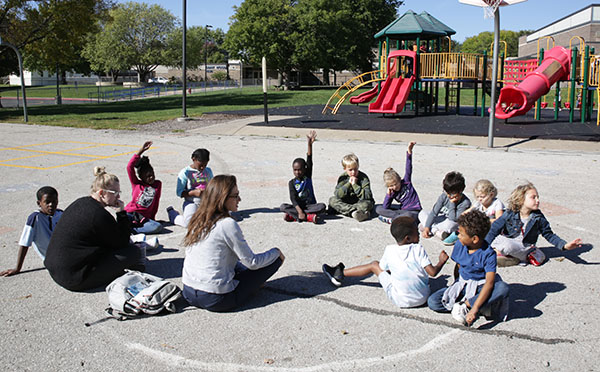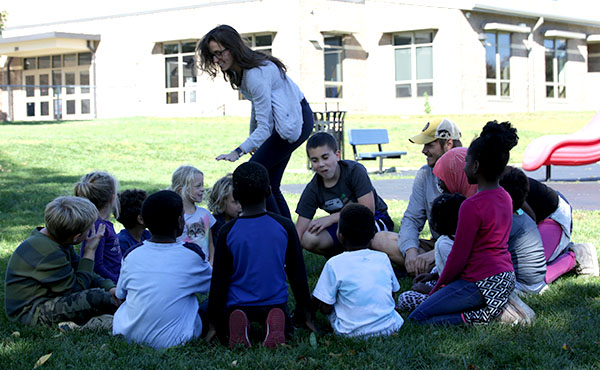Breadcrumb
Healthy LifeStars program teaches kids important habits for lifelong health
By Debra Venzke
Published on December 13, 2018
 On a sunny fall afternoon, a group of second- and third-graders sits in a circle on the playground to talk about goals.
On a sunny fall afternoon, a group of second- and third-graders sits in a circle on the playground to talk about goals.
“Who can tell me what that word means?” asks Hailey Boudreau, a graduate student who is guiding the discussion at an after-school program.
The kids’ hands shoot up as fast as their answers: “Winning!” “Medals!” “A trophy!”
“You study and practice to pass a test,” Boudreau continues. “Does it make you happy when you pass?”
The kids nod.
“How about exercise? What’s your goal for exercise?”
“Sixty minutes a day!” several kids shout.
“So we need goals to help us move forward, right?” Boudreau asks.
The kids soon put their exercise goal into action as Boudreau leads them in lively games of sharks and minnows, freeze tag, and duck, duck, goose.
Boudreau is serving as a coach for Healthy LifeStars, an innovative program aimed at reducing childhood obesity. Developed for elementary-age kids, the program motivates and teaches children to set personal health goals, be active every day, and eat the right foods in the right amounts.
Teaching Healthy Habits
The program is being implemented through a partnership between Healthy LifeStars and the Iowa Institute of Public Health Research and Policy (IIPHRP) based in the University of Iowa (UI) College of Public Health. Healthy LifeStars is a national non-profit organization dedicated to ending childhood obesity through education, awareness, and changed habits to influence future generations of healthy children.
Healthy LifeStars was founded in 2003 and has reached over 35,000 schoolchildren in Arizona and Colorado. In 2018, it launched programs in Iowa and Ohio and has the goal of growing nationwide.
“Nationally, one in three children is overweight or obese,” says Edith Parker, dean of the College of Public Health. “We’re excited to introduce this program in Iowa and expand it statewide to help teach kids healthy, lifelong habits.”
The program is offered in Iowa at no charge, thanks to a gift from the Stead Family Foundation and Jerre and Mary Joy Stead, two former Iowans who are among the most generous donors to the University of Iowa.
Partnership Power
 Healthy LifeStars started in Iowa this fall with several sites in the Iowa City area. The program is delivered in before- and after-school programs and is led in part by UI student coaches.
Healthy LifeStars started in Iowa this fall with several sites in the Iowa City area. The program is delivered in before- and after-school programs and is led in part by UI student coaches.
“We’re building a network of student volunteers who are an integral part of getting this program off the ground in our state,” says Vickie Miene, interim director of IIPHRP and director of the Iowa Healthy LifeStars program. Students from a variety of majors volunteer as coaches and contribute ideas to the program through a UI student advisory council. In addition, students contribute to social media articles and healthy lifestyle campaigns associated with the program.
IIPHRP will partner with additional schools, youth-serving organizations, and health initiatives to continue to grow the program across the state. The goal is to enroll 5,400 Iowa children in the first three years in both urban and rural locations.
To help motivate kids to reach their goals, each Healthy LifeStars participant receives a lanyard and chain to display reward tokens. Kids earn a colorful plastic star every time they achieve one of the goals they set for themselves.
Connecting the Dots
Boudreau, who is earning a Master of Public Health degree in community and behavioral health at the UI College of Public Health, visits Grant Wood Elementary in Iowa City twice a week to work with groups of K-6 students.
“It’s amazing, the connections the kids are able to make between all of the subjects,” she says. “For example, when we talked about nutrition, the kids were able to make the connection between skipping meals or eating poor options for lunch and how they would feel during class and recess.”
Boudreau also enjoys playing active games with the students.
“During our exercise lesson recently, we talked about feelings while exercising. They spoke about feeling sweaty, tired, and sore, but also about how they laugh and smile,” she says. “We all laugh and smile when we start our activity portion of the class. It’s contagious!”
This story originally appeared in the fall 2018 issue of InSight magazine